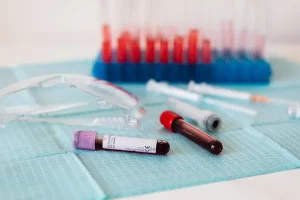10 most important blood tests (with lab values)

There is no one single test that tests for everything.
But, for a broad overview of your health, a full blood count (FBC), U&Es, glucose/HbA1c, bone biochemistry and liver function tests (LFTs) are considered the best blood tests.
In this article, we will describe 10 most important blood tests, and give their lab values.
Haematology
1. Full blood count (FBC)
This test measures three components of your blood (red blood cells, white blood cells, and platelets). It can help identify issues like anemia, infection, or inflammation, and even some types of cancer.
- Haemoglobin (‘Hb’)
- 130-170 g/L for men
- 110-150 g/L for women
- The Hb reflects the number of red cells (which carry oxygen) in the blood – a higher number means more red cells. A low haemoglobin is called anaemia. A high haemoglobin is called polycythaemia
- White cell count (WC) = 4-11 x10^9/L (million per litre). These cells fight infection (and cancer and foreign bodies inside you)
- Platelet count = 150-400 x10^9/L (million per litre). These cells clot the blood.
Biochemistry
These tests assess your liver, kidney health, as well as other essential substances.
It can detect conditions like diabetes, chronic kidney disease (CKD), or liver problems. In the USA, it is sometimes called a Comprehensive Metabolic Panel (CMP).
It usually comprises U&Es, glucose/HbA1c, liver function tests (LFTs) and bone biochemistry. Hence a phrase ‘U+E, gluc, LFTs and bone’ is sometimes used to describe this group of tests.
We wll now go through them in more detail.
2. U&E (urea and electrolytes)
- Sodium (Na) = 135-145 mmol/L
- Potassium (K) = 3.5-5.3 mmol/L
- Urea (U) = 3-7 mmol/L. High in CKD or AKI
- Creatinine (Creat) = 60-120 μmol/L. High in CKD or AKI
- Glomerular filtration rate (GFR) = 90-120 ml/min/1.73m². Low in CKD – how your CKD stage is calculated.
3. Blood glucose = 4-6 mmol/L – and less than 8 mmol/L, two hours after a meal
- Prediabetes is diagnosed if your random blood glucose = 7-11 mmol/L
- Diabetes is diagnosed if your random blood glucose > 11 mmol/L (or a fasting blood glucose > 7 mmol/L)
4. Haemoglobin A1c (HbA1c)= 20-42 mmol/mol (or 4-6%)
- Prediabetes is diagnosed if your HbA1c = 42-47 mmol/mol (6-6.5%)
- Diabetes is diagnosed if your HbA1c > 47 mmol/mol or over (>6.5%).
5. Liver function tests (LFTs) – also called liver enzymes
- Bilirubin (bili) = <21 µmol/L. High in liver disease
- Alkaline phosphatase (alk phos, ALP) = 30-130 IU/L. There are bone and liver types of alk phos
- ɣ–glutamyl transpedtidase (GGT) = 1-55 IU/L
- Alanine aminotransferase (ALT) = 15-45 IU/L
- Aspartate aminotransferase (AST) = 15-42 IU/L
- Albumin (Alb) = 35-50 g/L. Low in liver disease
- Globulin (Glob) = 20-40 g/L
- Total protein (TP) = 60-80 g/L.
6. Bone biochemistry
- Calcium (Ca) = 2.2-2.6 mmol/L. Primary mineral in bones, and is crucial for bone health
- Phosphate (PO4) = 0.8-1.4 mmol/L. Also essential for bone structure and works in conjunction with calcium
- Alkaline phosphatase (alk phos, ALP) = 30-130 U/L. An enzyme that indicates bone turnover.
Other tests
7. Cholesterol (and lipids)
- Total cholesterol (chol) = 3-5 mmol/L. Overall amount of cholesterol in your blood
- HDL (‘good’) cholesterol. Target level = >1 mmol/L May make you less likely to have a heart attack or stroke
- Non-HDL/LDL (‘bad’) cholesterol. Target level = <4 mmol/L. May make you less likely to have a heart attack or stroke
- Triglyceride (TG). Target level = <1.7 mmol/L
- Cholesterol/HDL ratio = <4.
8. Thyroid function tests (TFTs)
- TSH: 0.5 – 5.0 mU/L. Most important thyroid test. High TSH indicates an underactive thyroid – low indicates overactive
- Free thyroxine (T4): 8.0 – 18.0 pmol/L
- Free triiodothyronine (T): 3.8 – 6.0 pmol/L.
9. Cardiac (heart) biomarkers
- B-type natriuretic peptide (BNP) = <100 pg/mL. Sign of heart failure
- Aminoterminal pro B-type natriuretic peptide (NT-proBNP) = <400 pg/mL. Another test for heart failure.
10. PSA (prostate specific antigen)
- Prostate specific antigen (PSA; men only) = <3 ng/ml. A high level of PSA can be a sign of prostate cancer. But your PSA level can also be raised in prostate conditions that are not cancer (see here).
Summary
We have described 10 most important blood tests, and given their lab values. We hope it has been helpful.

